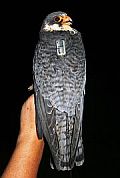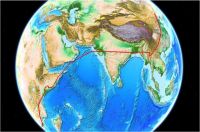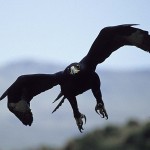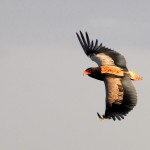Amur Falcon migration route finally plotted

Bernd Meyburg and his team has presented the first ever satellite tracking data for Amur Falcons at two conferences, one in the East (Asian Raptor Research and Conservation Network conference, Mongolia) and one in South Africa (Birds of Prey Programme Conference, Kimberley). The information gathered on 7 tracked Amur Falcons most probably represents the most exciting satellite tracking data from raptors since the first long distance raptor migrants were tracked. The Amur Falcon has one of the longest raptor migrations, but is also unique because it supposedly flies a long distance over the sea. It was believed that they flew mostly over land during their return journey, but data from Bernd has shown that they fly a distance 2,500 to 3,100km over the sea in spring and do this by flying non-stop for between 2 and 3 days. Other interesting information presented include that there is quite a lot of movement between roosts in their wintering area, they have stop over points on their migration route back to the breeding grounds, and fly south of the Himalayas in northern India. They are also capable of covering huge amounts of distance in a few days and were able to travel up much of Africa in only a few days. They have now arrived in their breeding grounds and hopefully Prof Meyburg will be able to track their return route back to South Africa at the end of the year. One wonders if they will return to the same roost?

Satellite tracking of raptors on migration has become an indispensable tool in studying the routes taken by birds. It is especially useful when used in areas where there are little chance of recovering ringed birds.In the past, it was not possible to track any of the small falcons due to the size of the satellite transmitters. However, in 2009, the first transmitters became available that were small enough not to affect the survival of the birds (typically <3% of the body mass). Several studies have used these, including those on Eleanora’s Falcon, Sooty Falcon, Hobby Falcon and Redfooted Falcon.The Amur Falcon stands out as one of the most interesting birds to track. It migrates over a very long distance (eastern China to southern Africa), it has different routes to and from its breeding grounds and it supposedly flies several thousands of its journey across the sea.Bernd Meyburg visited South Africa in January 2010, and with the help of Zephne and Herman Bernitz and Rina Pretorius and Sylva Francis, all volunteers of the Migrating Kestrel Project, trapped 10 Amur Falcons at the massive Newcastle roost and fitted satellite transmitters to these birds.Already the data collected from these birds have shown that they are capable of moving large distances each day, and do move around between roosts. We look forward to watching them as they move back to their breeding grounds, where ever these are!
Prof. Dr. Bernd-Ulrich Meyburg is Chair of the World Working Group on Birds of Prey and head of the NABU Federal Working Group on Bird of Prey Protection.




Great work by Dr B Meyburg.
Dear Munir and Marcus, thank you for posting the valuable info on your site
Best regards
Satish Pande, Pune, India
Thank you for sharing this great info with us…living so close to the cape town mountains as we do we are very aware of all these birds of prey! info is invaluable! Thanks again!
Rina Pretorius from Newcastle and one of the volunteers involved in the project, has just addressed us – the Birdlife KwaZulu Natal Forum Meeting on Sat 5 March 2011.
She gave us the latest information on the return of the birds. Seven of the ten returned safely to their Newcastle roosts, following the same route except that they were ~250-350kms further south over the ocean. If you would like an update for this fantastic Blog then email amurfalconringer@gmail.com and you should get the latest info.
Well done to the volunteers who helped erect the nets and to Dr Meyburg. Carolyn Mc Donald
tours@meetusinafrica.co.za
Saw these birds coming in to roost at Mooi River last evening. A precious moment for us city dwellers! Wonder why they chose 5 Pine Trees in the middle of Mooi River where the big trucks let off steam next to an Engen garage………?
Have just read a wonderful article in The Star newspaper, Monday 27 June 2011 page 9, Johannesburg and was astounded by it! Follow up article appeared on Tuesday 28 July 2011.
Thank you for all your efforts and look forward to more of the same!
Listened to your talk on 702 yesterday, with is information provided here, the picture is now halfway done. Wishing for a safe return of those tagged birds. This is fantastic, thanks.
Absolutely stunning article in local newspaper The Mercury re this fabulous journey. John Gardiner’s letter entitled “Nature, not humans makes my spirit soar” sums it all up in great writing. Congratulations to all involved.
A very interesting find. On 6th November –I found 500+ Amur Falcons staying in an area of eastern lowlands for more than a week.
Their journey must be Africa-bound? Any thing we can do on these and migrating raptors in Khare and Kali Gandaki Valley would be great.
Hem Sagar Baral
This is fantastic work, thanks for publishing the results. We have a large number of these most beautiful little falcons in Zimbabwe right now. Thousands roost in and around Harare and we have always marvelled at the distance they have to come and it is great to actually know the route now.
Wonderful information. I looked up this falcon as it has been spotted here near Knysna, W Cape which is according to most books further souith than its range. Seen in groups arround cultivated fields.
Hi .I live in mooi river and I have been very interested in these birds . There used to be thousands of them in the 4 plane trees in town . But this year 2012 very few and have arrived late . Could it be weather patterns that have made them late ? Or have some split up and gone too other roosts …. ? I know of two other roosts in sa . Under Berg and lindley in the free state .. Regard justin
Hi Justin,
I was passing through Mooi River early this morning and witnessed the most amazing scene as thousands of these birds were leaving their roosting spot (4 plane trees). It was incredible! Regards, Kevin
hii,
Saw this today on 15th April 2012. at Virar Near Mumbai, Maharashtra, India. see the pic.
https://www.facebook.com/photo.php?fbid=427137900633069&set=a.297232863623574.88301.100000105870638&type=1&theater
Fascinating account of a fascinating journey. Thank you. By the way, has the reported trapping of Amur falcons in Nagaland had an observed effect on the numbers of these birds arriving in Southern Africa compared to other years and on insect populations? Regards, Rohan, Colombo, Sri Lanka.
[…] exact migration path of this medium size slender bird species is still unknown butit has one of the longest migration routes of all birds, doing up to 22,000 km in a year. This includes an amazing 3,000 km flight across the Indian Ocean […]
[…] exact migration path of this medium size slender bird species is still unknown butit has one of the longest migration routes of all birds, doing up to 22,000 km in a year. This includes an amazing 3,000 km flight across the Indian Ocean […]